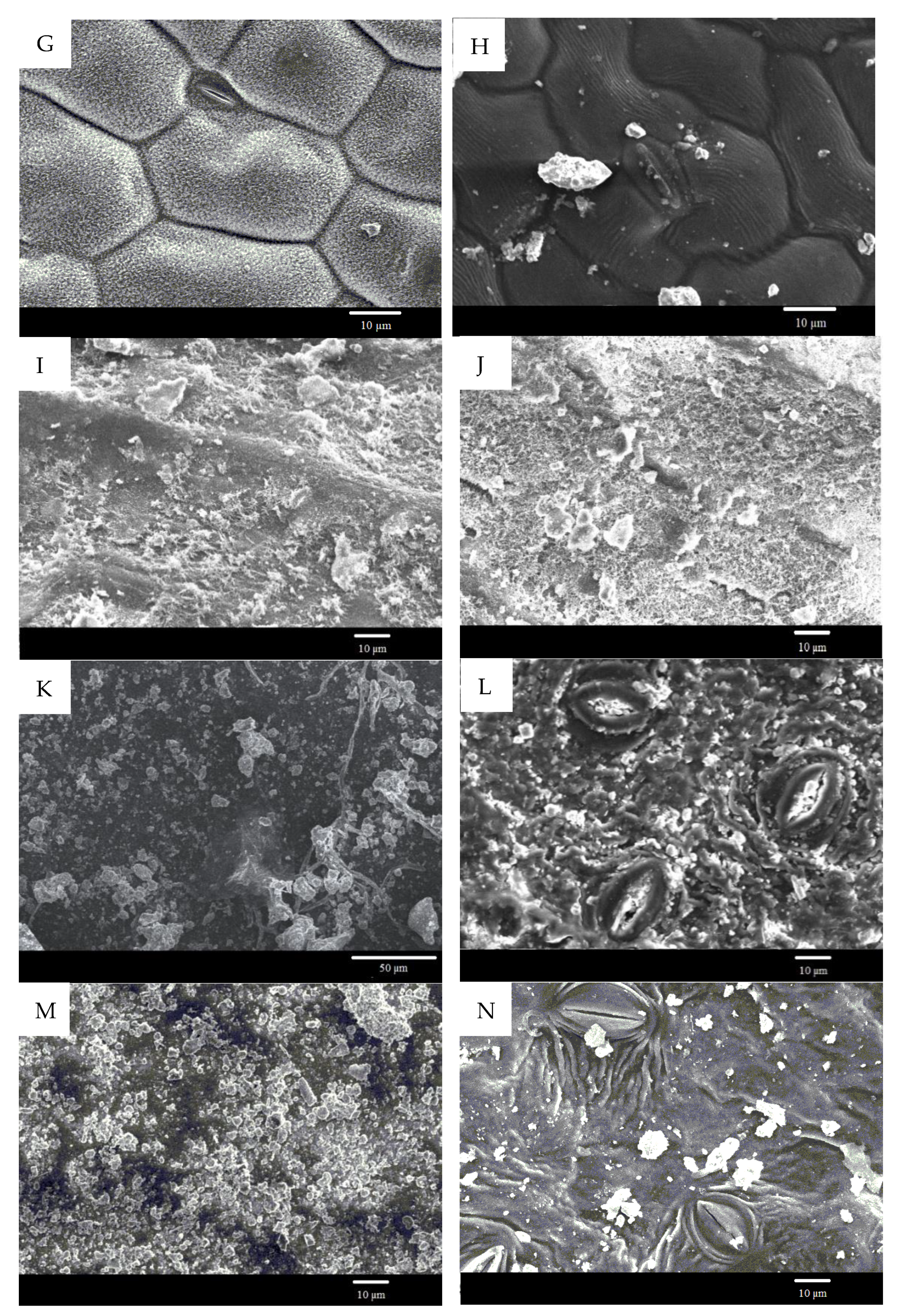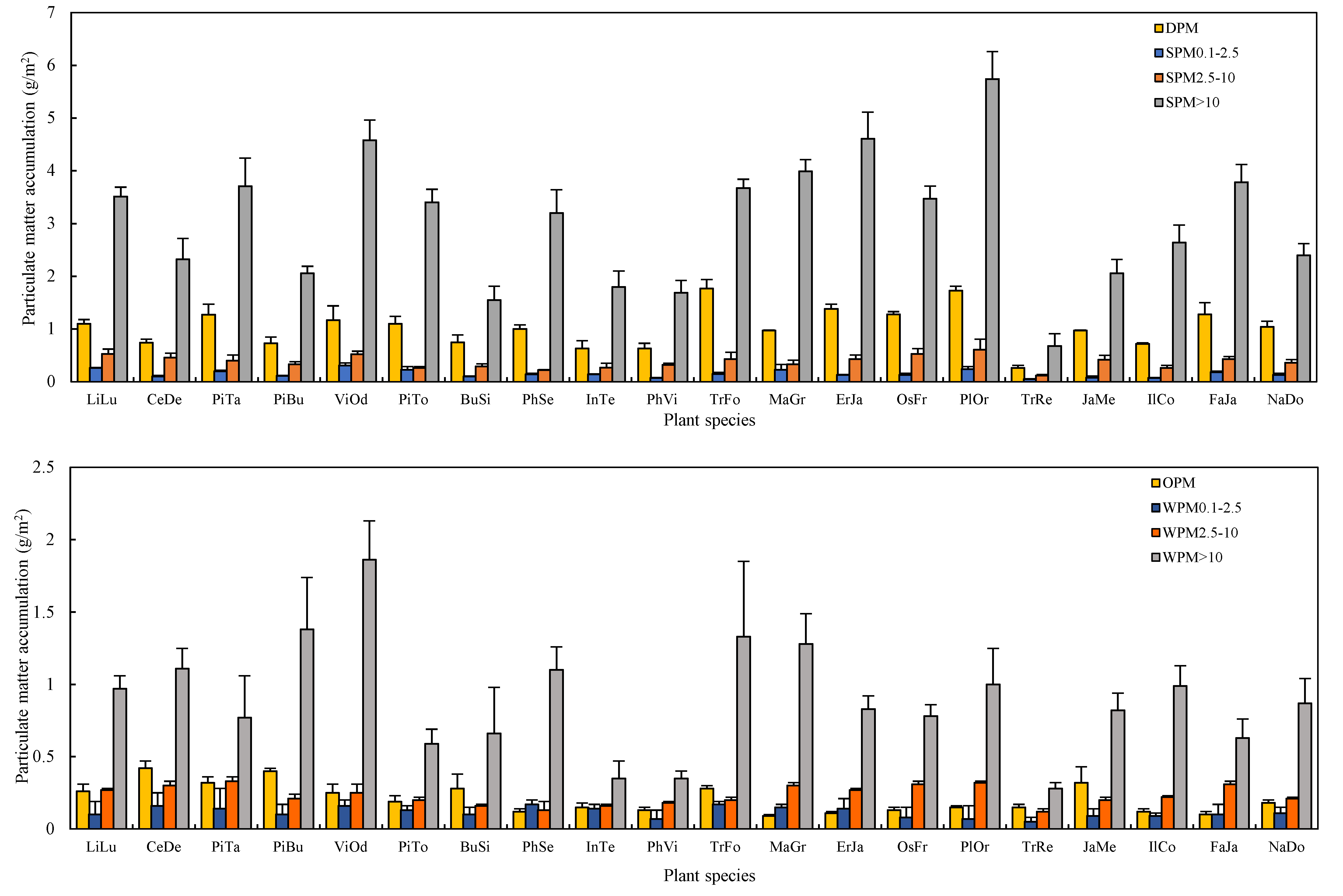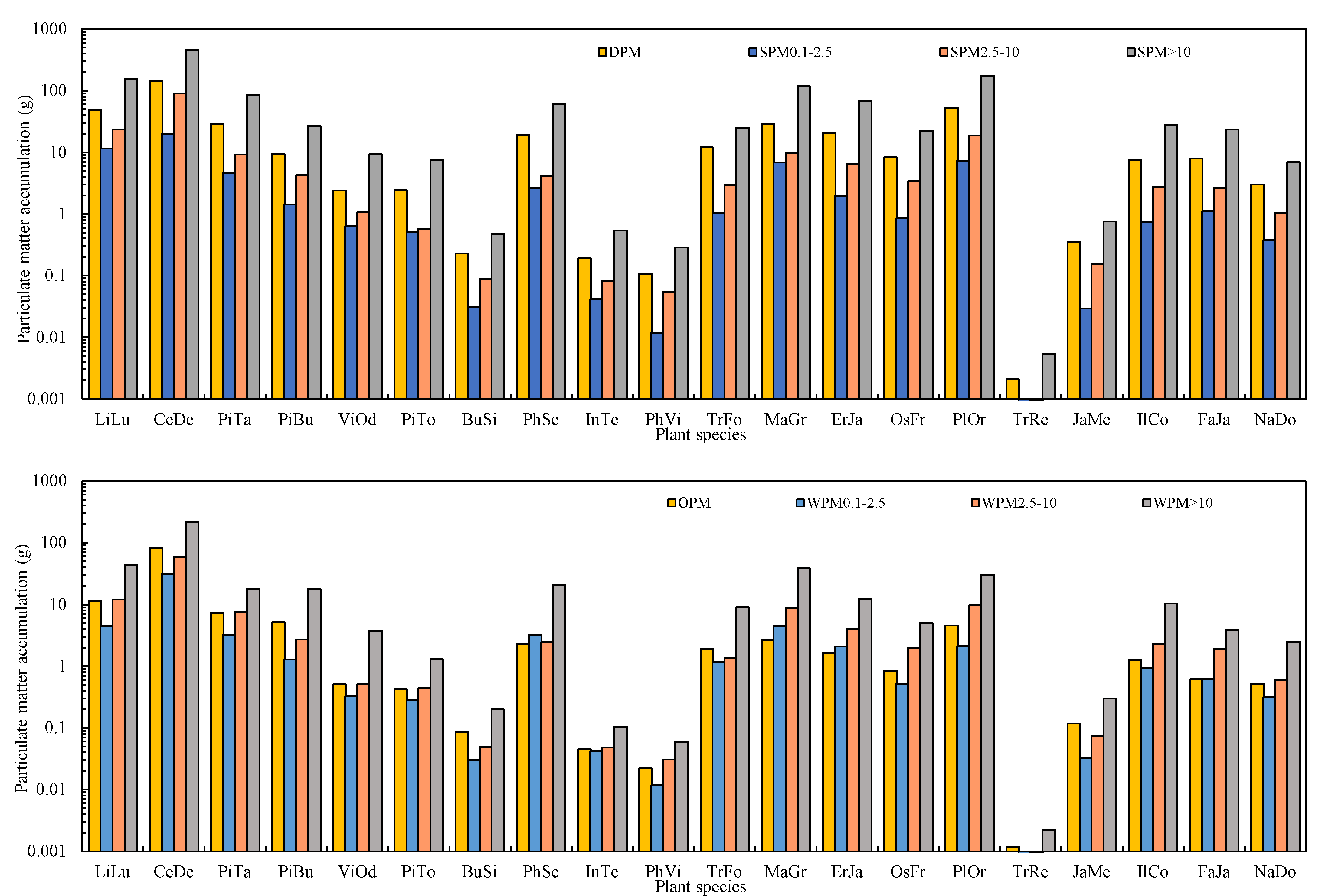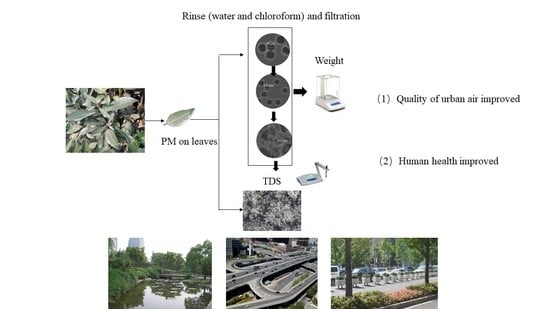Particle Retention Capacity, Efficiency, and Mechanism of Selected Plant Species: Implications for Urban Planting for Improving Urban Air Quality
Abstract
:1. Introduction
2. Results
2.1. Leaf Surface Micromorphology of Different Plant Species
2.2. PM Elution Characteristics of Different Plant Species
2.3. PM Retention Capacity of the Different Plant Species
2.4. The PM Retention Efficiency of the Different Tree Species
2.5. Relationships between Leaf PM Retention and Surface Wettability, Surface Free Energy
3. Discussion
3.1. Methods for Quantifying PM on Leave Surfaces
3.2. The Effects of Leaf Surface Microstructures on PM Retention
3.3. The Proper Index for Evaluating the PM Accumulation of Leave Surfaces of Plant Species
4. Materials and Methods
4.1. Plant Materials and Leaf Sampling
4.2. Experimental Methods
4.2.1. Measurement of Leaf PM Retention Amount
4.2.2. Measurement of Plant Characteristics
Measurement of Leaf Area
Measurements of Above-Ground Growth Status
4.2.3. Observation of Leaf Surface Microstructure
4.2.4. Measurements of Leave Contact Angle
4.2.5. Calculation of Leaf SFE
4.3. Data Presentation
4.4. Data Analysis
5. Conclusions
Author Contributions
Funding
Institutional Review Board Statement
Informed Consent Statement
Data Availability Statement
Acknowledgments
Conflicts of Interest
References
- Dominick, D.; Juahir, H.; Latif, M.T.; Zain, S.M.; Aris, A.Z. Spatial assessment of air quality patterns in Malaysia using multivariate analysis. Atmos. Environ. 2012, 60, 172–181. [Google Scholar] [CrossRef]
- Lim, C.H.; Ryu, J.; Choi, Y.; Joen, S.W.; Lee, W.K. Understanding global PM2.5 concentrations and their drivers in recent decades (1998–2016). Environ. Int. 2020, 144, 106011. [Google Scholar] [CrossRef]
- World Health Organization (WHO). Evolution of WHO Air Quality Guidelines: Past, Present and Future; WHO Regional Office for Europe: Copenhagen, Denmark, 2017. [Google Scholar]
- Wang, H.X.; Maher, B.A.; Ahmed, I.A.M.; Davison, B. Efficient removal of ultrafine particles from diesel exhaust by selected tree species: Implications for roadside planting for improving the quality of urban air. Environ. Sci. Technol. 2019, 53, 6906–6916. [Google Scholar] [CrossRef] [PubMed]
- WHO. Health Effects of Particulate Matter: Policy Implications for Countries in Eastern Europe, Caucasus and Central Asia. Available online: http://www.euro.who.int/__data/assets/pdf_file/0006/189051/Health-effects-of-particulate-matter-final-Eng.pdf (accessed on 12 March 2021).
- Li, L.; Wang, W.; Feng, J.L.; Zhang, D.P.; Li, H.J.; Gu, Z.P.; Wang, B.J.; Sheng, G.Y.; Fu, J.M. Composition, source, mass closure of PM2.5 aerosols for four forests in eastern China. J. Environ. Sci. 2010, 22, 405–412. [Google Scholar] [CrossRef]
- Barwise, Y.; Kumar, P. Designing vegetation barriers for urban air pollution abatement: A practical review for appropriate plant species selection. Clim. Atmos. Sci. 2020, 3, 12. [Google Scholar] [CrossRef] [Green Version]
- Tong, Z.M.; Baldauf, R.W.; Isakov, V.; Deshmukh, P.; Zhang, K.M. Roadside vegetation barrier designs to mitigate near-road air pollution impacts. Sci. Total Environ. 2016, 541, 920–927. [Google Scholar] [CrossRef] [PubMed]
- Weerakkody, U.; Dover, J.W.; Mitchell, P.; Reiling, K. Evaluating the impact of individual leaf traits on atmospheric particulate matter accumulation using natural and synthetic leaves. Urban For. Urban Gree. 2018, 30, 98–107. [Google Scholar] [CrossRef]
- Flett, L.; McLeod, C.L.; McCarty, J.L.; Shaulis, B.J.; Fain, J.J.; Krekeler, M.P.S. Monitoring uranium mine pollution on Native American lands: Insights from tree bark particulate matter on the Spokane Reservation, Washington, USA. Environ. Res. 2021, 194, 110619. [Google Scholar] [CrossRef] [PubMed]
- Sæbø, A.; Popek, R.; Nawrot, B.; Hanslin, H.M.; Gawrońska, H.; Gawronski, S.W. Plant species differences in particulate matter accumulation on leaf surfaces. Sci. Total Environ. 2012, 427–428, 347–354. [Google Scholar] [CrossRef]
- Abhijith, K.V.; Kumar, P. Quantifying particulate matter reduction and their deposition on the leaves of green infrastructure. Environ. Pollut. 2020, 265, 114884. [Google Scholar] [CrossRef]
- Nowak, D.J.; Hirabayashi, S.; Doyle, M.; McGovern, M.; Pasher, J. Air pollution removal by urban forests in Canada and its effect on air quality and human health. Urban For. Urban Green. 2018, 29, 40–48. [Google Scholar] [CrossRef]
- Wang, H.X.; Shi, H.; Wang, Y.H. Dynamics of the captured quantity of particulate matter by plant leaves under typical weather conditions. Acta Ecol. Sin. 2015, 35, 1696–1705, (In Chinese with English abstract). [Google Scholar]
- Dzierzanowski, K.; Popek, R.; Gawrońska, H.; Sæbø, A.; Gawroński, S.W. Deposition of particulate matter of different size fractions on leaf surfaces and in waxes of urban forest species. Int. J. Phytoremediat. 2011, 13, 1037–1046. [Google Scholar] [CrossRef] [PubMed]
- Zhang, Z.D.; Xi, B.Y.; Cao, Z.G.; Jia, L.M. Exploration of a quantitative methodology to characterize the retention of PM2.5 and other atmospheric particulate matter by plant leaves: Taking Populus tomentosa as an example. Chin. J. Appl. Ecol. 2014, 25, 2238–2242, (In Chinese with English abstract). [Google Scholar]
- Yan, J.L.; Lin, L.; Zhou, W.Q.; Ma, K.M.; Pickett, S.T.A. A novel approach for quantifying particulate matter distribution on leaf surface by combining SEM and object-based image analysis. Remote Sens. Environ. 2016, 173, 156–161. [Google Scholar] [CrossRef]
- Sternberg, T.; Viles, H.; Cathersides, A.; Edwards, M. Dust particulate absorption by ivy (Hedera helix L) on historic walls in urban environments. Sci. Total Environ. 2010, 409, 162–168. [Google Scholar] [CrossRef] [PubMed]
- Li, Y.F.; Yang, G.L.; Li, F.G.; Yu, L.S. Processing and analysis for micrograph of PM2.5 in atmosphere. Opto-Electron. Eng. 2005, 32, 54–58, (In Chinese with English abstract). [Google Scholar]
- Wang, Z.H.; Li, J.B. Capacity of dust uptake by leaf surface of Euonymus japonicus Thunb. and the morphology of captured particle in air polluted city. Ecol. Environ. 2006, 15, 327–330, (In Chinese with English abstract). [Google Scholar]
- Zhang, L.; Zhang, Z.Q.; Chen, L.X.; McNulty, S. An investigation on the leaf accumulation-removal efficiency of atmospheric particulate matter for five urban plant species under different rainfall regimes. Atmos. Environ. 2019, 208, 123–132. [Google Scholar] [CrossRef]
- Xu, X.W.; Zhang, Z.M.; Bao, L.; Li, M.; Yu, X.X.; Fan, D.X.; Lun, X.X. Influence of rainfall duration and intensity on particulate matter removal from plant leaves. Sci. Total Environ. 2017, 609, 11–16. [Google Scholar] [CrossRef]
- Liu, H.H.; Cao, Z.G.; Jia, L.M.; Li, X.Z.; Hao, L.F.; Liu, J.Q.; Wang, H.; Xi, B.Y. Analysis of the role of ultrasonic cleaning in quantitative evaluation of the retention of tree leaves to atmospheric particles: A case study with Ginkgo biloba. Sci. Silvae Sin. 2016, 52, 133–140, (In Chinese with English abstract). [Google Scholar]
- Liu, J.Q.; Cao, Z.G.; Zou, S.Y.; Liu, H.H.; Hai, X.; Wang, S.H.; Duan, J.; Xi, B.Y.; Yan, G.X.; Zhang, S.W.; et al. An investigation of the leaf retention capacity, efficiency and mechanism for atmospheric particulate matter of five greening tree species in Beijing, China. Sci. Total Environ. 2018, 616–617, 417–426. [Google Scholar] [CrossRef] [PubMed]
- Xu, H.M.; Cao, J.J.; Chow, J.C.; Huang, R.J.; Shen, Z.X.; Chen, L.W.A.; Ho, K.F.; Watson, J.G. Inter-annual variability of wintertime PM2.5 chemical composition in X’’an, China: Evidences of changing source emissions. Sci. Total Environ. 2016, 545–546, 546–555. [Google Scholar] [CrossRef] [PubMed]
- Tao, J.; Zhang, L.M.; Engling, G.; Zhang, R.J.; Yang, Y.H.; Cao, J.J.; Zhu, C.S.; Wang, Q.Y.; Luo, L. Chemical composition of PM2.5 in an urban environment in Chengdu, China: Importance of springtime dust storms and biomass burning. Atmos. Res. 2013, 122, 270–283. [Google Scholar] [CrossRef]
- Galon-Negru, G.A.; Olariu, R.I.; Arsene, C. Size-resolved measurements of PM2.5 water-soluble elements in Iasi, north-eastern Romania: Seasonality, source apportionment and potential implications for human health. Sci. Total Environ. 2019, 695, 133839. [Google Scholar] [CrossRef]
- Jacobson, M.C.; Hansson, H.C.; Noone, K.J.; Charlson, R.J. Organic atmospheric aerosols: Review and state of the science. Rev. Geophys. 2000, 38, 267–294. [Google Scholar] [CrossRef] [Green Version]
- Grosjean, D. Solvent extraction and organic carbon determination in atmospheric particulate matter: The organic extraction organic carbon analyze (OE-OCA) technique. Anal. Chem. 1975, 47, 797–805. [Google Scholar] [CrossRef]
- Zhang, F. Studies on the Existing Shrubs of the Road in Changchun and the Dust Eetention Capacity of the Three Shrubs. Master Dissertation, Jilin Agricultural University, Changchun, China, 2013. [Google Scholar]
- Chen, L.X.; Liu, C.M.; Zou, R.; Yang, M.; Zhang, Z.Q. Experimental examination of effectiveness of vegetation as bio-filter of particulate matter in the urban environment. Environ. Pollut. 2016, 208, 198–208. [Google Scholar] [CrossRef]
- Xu, Y.S.; Xu, W.; Mo, L.; Heal, M.R.; Xu, X.W.; Yu, X.X. Quantifying particulate matter accumulated on leaves by 17 species of urban trees in Beijing, China. Environ. Sci. Pollut. R. 2018, 25, 12545–12556. [Google Scholar] [CrossRef] [Green Version]
- Čeburnis, D.; Steinnes, E. Conifer needles as biomonitors of atmospheric heavy metal deposition: Comparison with mosses and precipitation, role of the canopy. Atmos. Environ. 2000, 34, 4265–4271. [Google Scholar] [CrossRef]
- Nieminen, T.M.; Derome, J.; Helmisaari, H.S. Interactions between precipitation and Scots pine canopies along heavy-metal pollution gradient. Environ. Pollut. 1999, 106, 129–137. [Google Scholar] [CrossRef]
- Hong, X.L.; Yang, X.Y.; Yang, M.Y.; Zhong, Y.X.; Li, C.; Zhang, T.; Liu, Y.J. A method of quantifying the retention of PM2.5 and other atmospheric particulates by plant leaves. J. Beijing For. Uni. 2015, 37, 147–154, (In Chinese with English abstract). [Google Scholar]
- Przybysz, A.; Sæbø, A.; Hanslin, H.M.; Gawroński, S.W. Accumulation of particulate matter and trace elements on vegetation as affected by pollution level, rainfall and the passage of time. Sci. Total Environ. 2014, 481, 360–369. [Google Scholar] [CrossRef]
- Popek, R.; Gawrońska, H.; Wrochna, M.; Gawroński, S.W.; Sæbø, A. Particulate matter on foliage of 13 woody species: Deposition on surfaces and phytostabilisation in waxes–a 3-year study. Int. J. Phytoremediat. 2012, 15, 245–256. [Google Scholar] [CrossRef] [PubMed]
- Song, Y.S.; Maher, B.A.; Li, F.; Wang, X.K.; Sun, X.; Zhang, H.X. Particulate matter deposited on leaf of five evergreen species in Beijing, China: Source identification and size distribution. Atmos. Environ. 2015, 105, 53–60. [Google Scholar] [CrossRef]
- Wang, H.X.; Shi, H.; Li, Y.Y.; Zhang, J. Seasonal variations in leaf capturing of particulate matter, surface wettability and micromorphology in urban tree species. Front. Env. Sci. Eng. 2013, 7, 579–588. [Google Scholar] [CrossRef]
- Wang, H.X.; Shi, H.; Li, Y.Y.; Wang, Y.H. The effects of leaf roughness, surface free energy and work adhesion on leaf water drop adhesion. PLoS ONE 2014, 9, e107062. [Google Scholar] [CrossRef]
- Zuo, N.; Wang, H.X.; Yang, Z.; Zhong, M.T.; Shi, H.; Wang, Y.H. The properties of Pinus bungeana captured particulates from atmosphere with different diameters at the breast height. Chin. J. Ecol. 2017, 36, 367–373, (In Chinese with English abstract). [Google Scholar]
- Chen, F.; Zhou, Z.X.; Wang, P.C.; Li, H.F.; Zhong, Y.F. Green space vegetation quantity in workshop area of Wuhan Iron and Steel Company. Chin. J. Appl. Ecol. 2006, 17, 592–596, (In Chinese with English abstract). [Google Scholar]
- Chen, Y.; Sui, H.D.; Feng, Z.K.; Sun, Y.Q. Comparative analysis on the precisions between two methods for tree height measurement. For. Inventory Plan. 2009, 34, 1–5, (In Chinese with English abstract). [Google Scholar]
- Knoll, D.; Schreiber, L. Influence of epiphytic micro-organisms on leaf wettability: Wetting of the upper leaf surface of Juglans regia and of model surfaces in relation to colonization by micro-organisms. New Phytol. 1998, 140, 271–282. [Google Scholar] [CrossRef]
- Gindl, M.; Sinn, G.; Gindl, W.; Reiterer, A.; Tschegg, S. A comparison of different methods to calculate the surface free energy of wood using contact angle measurements. Colloids Surf. A 2001, 181, 279–287. [Google Scholar] [CrossRef]
- Young, T. An essay on the cohesion of fluids. Philos. Trans. R. Soc. Lond. 1805, 95, 65–87. [Google Scholar]
- Fowkes, F.M. Determination of interfacial tensions, contact angles, and dispersion forces in surfaces by assuming additivity of intermolecular interactions in surfaces. J. Phys. Chem. 1962, 66, 382–386. [Google Scholar] [CrossRef]
- Owens, D.K.; Wendt, R.C. Estimation of the surface free energy of polymers. J. Appl. Polym. Sci. 1969, 13, 1741–1747. [Google Scholar] [CrossRef]
- Fernández, V.; Sancho-Knapik, D.; Guzmán, P.; Peguero-Pina, J.; Gil, L.; Karabourniotis, G.; Khayet, M.; Fasseas, C.; Heredia-Guerrero, J.A.; Heredia, A.; et al. Wettability, polarity and water absorption of Quercus ilex leaves: Effect of leaf side and age. Plant Physiol. 2014, 166, 168–180. [Google Scholar] [CrossRef] [PubMed] [Green Version]






| Species | AEleaf (mg/m2·d) | AEplant (mg/d) | AEland (mg/m2·d) | ||||||||||||
|---|---|---|---|---|---|---|---|---|---|---|---|---|---|---|---|
| Diameter Class | Diameter Class | Diameter Class | |||||||||||||
| DPM | PM0.1–2.5 | PM2.5–10 | PM>10 | SPM | DPM | PM0.1–2.5 | PM2.5–10 | PM>10 | SPM | DPM | PM0.1–2.5 | PM2.5–10 | PM>10 | SPM | |
| LiLu | 22.5 | 5.3 | 10.8 | 71.6 | 110.2 | 999.5 | 236.2 | 481.6 | 3189.3 | 4906.6 | 73.2 | 17.3 | 35.3 | 233.5 | 359.3 |
| CeDe | 15.1 | 2.0 | 9.4 | 47.4 | 73.9 | 2953.2 | 399.2 | 1836.1 | 9260.5 | 14,449.0 | 55.1 | 7.5 | 34.3 | 172.8 | 269.7 |
| PiTa | 25.9 | 4.1 | 8.2 | 74.7 | 112.9 | 594.5 | 93.6 | 187.2 | 1736.6 | 2611.9 | 49.8 | 7.8 | 15.7 | 145.4 | 218.7 |
| PiBu | 14.9 | 2.2 | 6.7 | 42.0 | 65.8 | 192.2 | 29.0 | 86.9 | 542.5 | 850.6 | 27.6 | 4.2 | 12.5 | 77.8 | 122.1 |
| ViOd | 23.9 | 6.3 | 10.6 | 93.5 | 134.3 | 48.7 | 12.9 | 21.6 | 190.6 | 273.8 | 99.3 | 26.3 | 44.2 | 388.8 | 558.6 |
| PiTo | 22.5 | 4.7 | 5.3 | 69.4 | 101.9 | 49.7 | 12.9 | 21.6 | 190.6 | 274.8 | 98.8 | 20.7 | 23.4 | 305.3 | 448.2 |
| BuSi | 15.3 | 2.0 | 5.9 | 31.6 | 54.8 | 4.7 | 0.6 | 1.8 | 9.6 | 16.7 | 41.0 | 5.5 | 15.9 | 84.8 | 147.2 |
| PhSe | 20.4 | 2.9 | 4.5 | 65.3 | 93.1 | 386.2 | 54.1 | 85.0 | 1235.9 | 1761.2 | 87.6 | 12.3 | 19.3 | 280.2 | 399.4 |
| InTe | 12.9 | 2.9 | 5.5 | 36.7 | 58.0 | 3.9 | 0.9 | 1.7 | 11.1 | 17.6 | 32.4 | 7.2 | 13.9 | 92.6 | 146.1 |
| PhSu | 12.9 | 1.4 | 6.5 | 34.5 | 55.3 | 2.2 | 0.2 | 1.1 | 5.9 | 9.4 | 17.4 | 1.9 | 8.8 | 46.6 | 74.7 |
| TrFo | 36.1 | 3.1 | 8.8 | 74.9 | 122.9 | 246.8 | 20.9 | 60.0 | 511.6 | 839.3 | 75.5 | 6.4 | 18.3 | 156.5 | 256.7 |
| MaGr | 19.8 | 4.7 | 6.7 | 81.4 | 112.6 | 588.7 | 139.6 | 200.3 | 2421.7 | 3350.3 | 77.0 | 18.3 | 26.2 | 316.8 | 438.3 |
| ErJa | 28.2 | 2.7 | 8.8 | 94.1 | 133.8 | 421.2 | 38.7 | 131.3 | 1407.1 | 1998.3 | 64.2 | 6.1 | 20.0 | 214.5 | 304.8 |
| OsFr | 26.1 | 2.7 | 10.8 | 70.8 | 110.4 | 169.7 | 17.2 | 70.3 | 460.0 | 717.2 | 61.1 | 6.2 | 25.3 | 165.7 | 258.3 |
| PlOr | 35.3 | 4.9 | 12.5 | 117.1 | 169.8 | 1080.1 | 149.8 | 380.8 | 3583.7 | 5194.4 | 79.1 | 11.0 | 27.9 | 262.4 | 380.4 |
| TrRe | 5.3 | 1.0 | 2.5 | 13.9 | 22.7 | 0.1 | 0.1 | 0.1 | 0.1 | 0.4 | 15.0 | 2.9 | 6.9 | 39.3 | 64.1 |
| JaMe | 19.8 | 1.6 | 8.6 | 42.0 | 72.0 | 7.2 | 0.6 | 3.1 | 15.4 | 26.3 | 40.0 | 3.3 | 17.3 | 84.9 | 145.5 |
| IlCo | 14.7 | 1.4 | 5.3 | 53.9 | 75.3 | 154.1 | 15.0 | 55.7 | 565.2 | 790.0 | 39.8 | 3.9 | 14.4 | 146.0 | 204.1 |
| FaJa | 26.1 | 3.7 | 8.8 | 77.1 | 115.7 | 161.9 | 22.8 | 54.4 | 478.0 | 717.1 | 88.0 | 12.4 | 29.6 | 260.0 | 390.0 |
| NaDo | 21.2 | 2.7 | 7.3 | 49.0 | 80.2 | 61.1 | 7.6 | 21.2 | 141.0 | 230.9 | 64.3 | 8.0 | 22.3 | 148.4 | 243.0 |
| Species | Contact Angle (°) | Surface Free Energy (mJ/m2) | |||
|---|---|---|---|---|---|
| Water | Diiodomethane | γp | γd | γ | |
| LiLu | 76.3 ± 8.8 | 55.9 ± 1.7 | 9.1 | 25.4 | 34.5 |
| CeDe | 68.8 ± 9.7 | 58.7 ± 6.3 | 15.0 | 22.0 | 37.0 |
| PiTa | 84.3 ± 4.6 | 54.9 ± 3.9 | 4.6 | 27.8 | 32.4 |
| PiBu | 73.3 ± 8.5 | 62.1 ± 7.4 | 12.8 | 20.8 | 33.6 |
| ViOd | 73.5 ± 7.3 | 55.2 ± 5.6 | 10.7 | 25.2 | 35.9 |
| PiTo | 80.4 ± 4.6 | 62.9 ± 3.7 | 8.3 | 21.9 | 30.2 |
| BuSi | 83.4 ± 9.4 | 54.9 ± 5.8 | 5.0 | 27.6 | 32.6 |
| PhSe | 63.3 ± 8.6 | 49.5 ± 8.7 | 16.2 | 26.4 | 42.6 |
| InTe | 87.5 ± 10.4 | 58.7 ± 3.5 | 3.9 | 26.1 | 30.0 |
| PhSu | 83.4 ± 7.2 | 56.5 ± 4.4 | 5.3 | 26.7 | 32.0 |
| TrFo | 59.7 ± 10.3 | 55.1 ± 5.9 | 20.9 | 22.5 | 43.4 |
| MaGr | 68.2 ± 14.2 | 54.4 ± 3.7 | 14.1 | 24.5 | 38.6 |
| ErJa | 49.7 ± 15.4 | 50.1 ± 8.5 | 27.3 | 23.5 | 50.8 |
| OsFr | 71.4 ± 6.0 | 51.1 ± 3.7 | 11.0 | 27.2 | 38.2 |
| PlOr | 66.3 ± 10.5 | 46.3 ± 6.9 | 13.2 | 28.9 | 42.1 |
| TrRe | 131.2 ± 4.3 | 104.9 ± 4.4 | 0.1 | 7.3 | 7.4 |
| JaMe | 80.1 ± 7.4 | 63.5 ± 6.1 | 8.7 | 21.5 | 30.2 |
| IlCo | 90.6 ± 10.1 | 59.9 ± 9.4 | 2.9 | 26.1 | 29.0 |
| FaJa | 68.7 ± 6.9 | 51.7 ± 4.7 | 12.9 | 26.3 | 39.2 |
| NaDo | 73.2 ± 4.5 | 55.9 ± 5.3 | 11.0 | 24.7 | 35.7 |
| Species | Abbreviation | Families | Life Form | Leaf Shape | Texture | Cluster |
|---|---|---|---|---|---|---|
| Ligustrum lucidum | LiLu | Oleaceae | Tree | Ovate, long ovate or elliptic to broadly elliptic | Leathery | 3 |
| Cedrus deodara | CeDe | Pinaceae | Tree | Needle | Leathery | 3 |
| Pinus tabuliformis | PiTa | Pinaceae | Tree | Needle | Leathery | 1 |
| Pinus bungeana | PiBu | Pinaceae | Tree | Needle | Leathery | 1 |
| Viburnum odoratissimum | ViOd | Caprifoliaceae | Shrub | Elliptic, rectangular-elliptic to obovate | Leathery | 3 |
| Pittosporum tobira | PiTo | Pittosporaceae | Shrub | Obovate or obovate lanceolate | Leathery | 3 |
| Buxus sinica | BuSi | Buxaceae | Shrub | Obovate to oblong ovate | Leathery | 1 |
| Photinia serrulata | PhSe | Rosaceae | Shrub | Obovate or obovate ellipse | Leathery | 3 |
| Indocalamus tessellatus | InTe | Gramineae | Herb | Elliptic lanceolate | Papery | 1 |
| Phyllostachys viridis | PhVi | Gramineae | Herb | Oblong lanceolate or lanceolate | Papery | 1 |
| Trachycarpus fortunei | TrFo | Palmae | Tree-dwelling | 3/4 orbicular or suborbicular | Leathery | 2 |
| Magnolia grandiflora | MaGr | Magnoliaceae | Tree | Ellipse, oblong ellipse or obovate ellipse | Leathery | 3 |
| Eriobotrya japonica | ErJa | Rosaceae | Tree | Lanceolate, oblanceolate, obovate, or oblong | Leathery | 2 |
| Osmanthus fragrans | OsFr | Oleaceae | Tree | Elliptic, oblong or elliptic lanceolate | Leathery | 2 |
| Platycladus orientalis | PlOr | Cupressaceae | Tree | Squamiform | Leathery | 2 |
| Trifolium repens | TrRe | Leguminosae | Herb | Ternate palmate leaf | Papery | 1 |
| Jasminum mesnyi | JaMe | Oleaceae | Shrub | Compound | Leathery | 2 |
| Ilex cornuta | IlCo | Aquifoliaceae | Shrub | Quadrangular oblong or ovate | Leathery | 2 |
| Fatsia japonica | FaJa | Araliaceae | Shrub | Palmate lobed | Leathery | 2 |
| Nandina domestica | NaDo | Berberidaceae | Shrub | Elliptic or elliptic lanceolate | Leathery | 2 |
Publisher’s Note: MDPI stays neutral with regard to jurisdictional claims in published maps and institutional affiliations. |
© 2021 by the authors. Licensee MDPI, Basel, Switzerland. This article is an open access article distributed under the terms and conditions of the Creative Commons Attribution (CC BY) license (https://creativecommons.org/licenses/by/4.0/).
Share and Cite
Wang, H.; Shi, H. Particle Retention Capacity, Efficiency, and Mechanism of Selected Plant Species: Implications for Urban Planting for Improving Urban Air Quality. Plants 2021, 10, 2109. https://doi.org/10.3390/plants10102109
Wang H, Shi H. Particle Retention Capacity, Efficiency, and Mechanism of Selected Plant Species: Implications for Urban Planting for Improving Urban Air Quality. Plants. 2021; 10(10):2109. https://doi.org/10.3390/plants10102109
Chicago/Turabian StyleWang, Huixia, and Hui Shi. 2021. "Particle Retention Capacity, Efficiency, and Mechanism of Selected Plant Species: Implications for Urban Planting for Improving Urban Air Quality" Plants 10, no. 10: 2109. https://doi.org/10.3390/plants10102109
APA StyleWang, H., & Shi, H. (2021). Particle Retention Capacity, Efficiency, and Mechanism of Selected Plant Species: Implications for Urban Planting for Improving Urban Air Quality. Plants, 10(10), 2109. https://doi.org/10.3390/plants10102109






